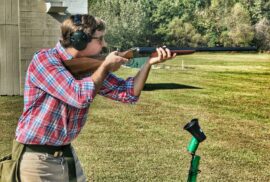
How Does Trap and Skeet Shooting Differ?
Trap and skeet shooting are two clay shooting sports in which participants shoot moving clay targets in various conditions. These sports originated as practice rounds for gunsmiths to shoot without harming live birds. But due to the rise of animal rights, these practices have grown into their very own sports.
The clay targets the shooter attempts to hit are shaped like an inverted saucer, called “pigeons” and “birds”, and have been primarily used since 1880. In the past, they used live pigeons or glass balls instead of clay targets. While both these sports sound inherently similar, they have considerable differences, which we will discuss below.
Trap Shooting
Trap shooting was first used to practice bird shooting and refine their shooting skills for a hunt in the 1800s. The targets used in modern trap shooting were added during the first official trap shooting competitive match in 1830. It still can be used as a great way to practice your shooting. As live bird hunting was outlawed in 1920, it became a competitive sport worldwide and has been played in the Olympics since 1886.
The main objective of this sport is to hit the clay birds while the target moves further away from the participant, who is impersonating a bird’s flight. The clay birds are shot into the air at 65kms an hour using an automated machine; shooters may know as a “house” or “bunker.” With every shot, the machine will choose a different direction and angle so the shooter can practice various scenarios. The only piece of information that the shooter knows is where the target originated from; everything else has to be discovered when the clay bird is released. It is an excellent challenge for any gunsmith or person interested in refining their shooting skills.
Usually, within a round, participants will release a total of 5 shots. These will be taken from five points on a lined, semi-circular field.
Skeet Shooting
Skeet shooting was created a century after trap shooting. The originator released that while trap shooting is an excellent way to refine your skills as a shooter, it did not mimic the behaviour of how real birds fly. The clay targets used in trap shooting were not spontaneous enough really prepare shooters for hunting live animals and birds of prey.
The main objective of this sport is to hit both targets simultaneously as they cross flight paths. The machines that propel the clay birds are automatic, placed 40 meters apart and at different heights, one at 10 feet and the other at 3.5 feet high. But both of these clay birds will rise to 15 feet by the time they intersect on the field and will travel over 70 km an hour.
The participant will complete their rounds from eight different locations on a semi-circular field. Throughout the game, every participant will release a total of 25 rounds. Throughout a game, there will be 17 targets that are singles and eight that are doubles.
The two types of skeet shooting, American and International, can have varying rules. In the American version, once the participant has indicated that a clay bird should be released, it is let go immediately. While there is no delay, these targets are fired at a slower pace. Also, the targets are released in a different sequence in both versions of skeet shooting. For international skeet shooting, once the target is called, there is a delay of up to three seconds before it is actually released. The international version of skeet shooting is used during the Olympic games.
What is the Difference Between Trap and Skeet Shooting
While both these sports have many similarities, such as using clay targets and playing on a semi-circular field, their fundamentals are quite different.
- Trap shooting has five stations, while skeet shooting has three extra.
- Within Skeet shooting, the amount of shots taken at each station varies, while in trap shooting, every person takes five shots at each station.
- In both trap and skeet shooting, the targets are released from an automated machine, but for trap shooting, that machine is near ground level, while with skeet shooting, the targets are released from different heights.
- During skeet shooting, the direction of the clay bird can change. It can either be moving away or towards the shooter. But with trap shooting, it will always be moving away, both of which require a different set of skills.
- Also, the speed at which the target moves differs for both sports. With trap shooting, the target moves at 65 km per hour, while in skeet, the target is released at over 70 km per hour.
Clay Shooting Components for a Gun
The gun of choice is primarily a shotgun for both skeet and trap shooting. If you want to be more competitive, it is better to have your gun tailored to the clay shooting sport you are competing in.
Trap guns possess one or two long barrels measuring up to 34 inches. They are heavy, have tight chokes and are, more often than not, twelve gauges. Due to their weight, it is easy to aim and shoot continually. These guns also contain straight stocks, which will help the participant aim high if needed.
Guns used in skeet shooting are also heavy but contain a shorter barrel than most trap guns. Usually, it measures 26-30 inches. The choke on these guns is very open, and its stock usually drops slightly. These guns are similar to trap guns as the user can easily continually shoot and absorb any recoil. Skeet guns are usually twelve gauges but can also be small bores and .410s.
Both skeet and trap shooting overall can be a great way to refine your shooting skills while having fun. If you are interested in finding out more about clay shooting and gunsmithing or want to learn more about interesting topics such as this one, check out MGS Trade School.
Written by: Ryan Clancy, Engineering HQ

